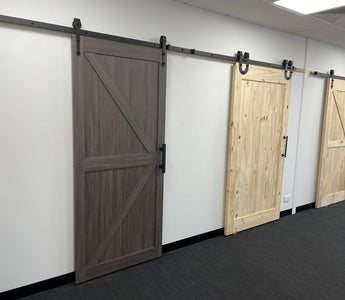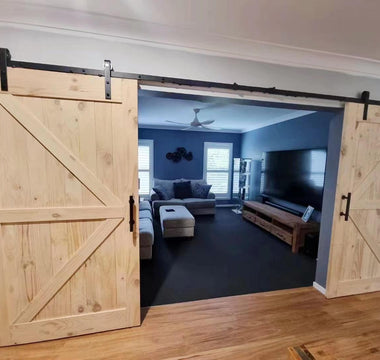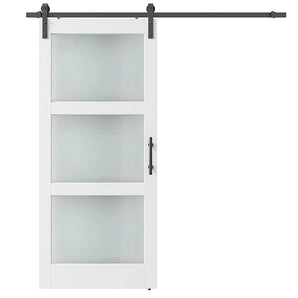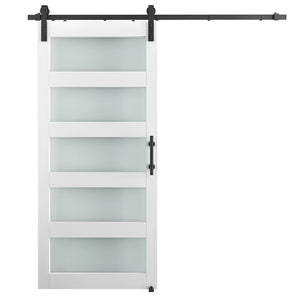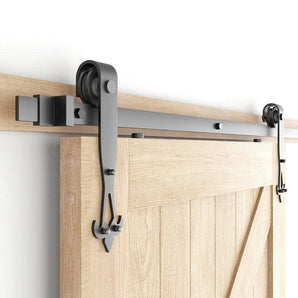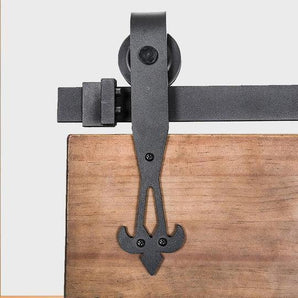
## Introduction to barn doors and header boards
Barn doors have become a popular choice for both residential and commercial spaces, adding a touch of rustic charm and functionality to any interior design. These sliding doors not only save space but also provide a unique aesthetic appeal. However, when it comes to installing barn doors, one crucial component that should not be overlooked is the header board.
A header board is a horizontal piece of wood or metal that is installed above the door frame. It serves as a support for the weight of the door and helps distribute the load evenly, ensuring a secure and functional barn door installation. It also plays a vital role in preventing sagging and warping of the door over time.
The role of a header board in barn door installation

The header board acts as the backbone of the barn door system. It provides stability and strength to the door, allowing it to operate smoothly and securely. Without a header board, the weight of the door would rest solely on the door frame, leading to potential structural damage and compromising the overall functionality of the door.
Additionally, the header board serves as a mounting surface for the track that the door slides along. It provides a secure and level base for the track, ensuring that the door operates smoothly without any hiccups or misalignment. This is especially important for heavier barn doors, as the header board helps distribute the weight evenly, preventing any strain on the track or door frame.
Benefits of using a header board

Using a header board in your barn door installation offers several benefits. Firstly, it enhances the overall stability and durability of the door. By providing additional support, the header board helps prevent any sagging or warping of the door, ensuring that it operates smoothly and remains in optimal condition for years to come.
Secondly, a header board allows for easier installation of the barn door. It provides a level and secure surface for attaching the track, eliminating the need for complicated adjustments or modifications to the door frame. This makes the installation process quicker and more efficient, saving both time and effort.
Furthermore, a header board can also enhance the aesthetic appeal of your barn door. It can be customized to match the style and finish of your door, adding a seamless and cohesive look to your interior design. Whether you prefer a rustic wooden header board or a sleek metal one, it can be a visually pleasing addition to your barn door system.
Types of header boards for barn doors

When it comes to choosing a header board for your barn door, there are several options to consider. The most common materials used for header boards are wood and metal, each with its own advantages and considerations.
Wooden header boards are a popular choice due to their natural beauty and versatility. They can be easily stained or painted to match the color scheme of your door and interior. However, it is important to ensure that the wood is properly treated to prevent any potential issues such as warping or rotting.
Metal header boards, on the other hand, offer excellent durability and strength. They are less prone to damage from moisture or pests, making them a suitable choice for barn doors installed in outdoor or high-humidity environments. Metal header boards are available in various finishes, including brushed steel, black powder-coated, or even custom-painted options.
How to choose the right header board for your barn door

Choosing the right header board for your barn door installation is crucial to ensure its functionality and longevity. Here are some factors to consider when selecting a header board:
-
Weight capacity: Determine the weight of your barn door and choose a header board that can support it. It is essential to select a header board with a weight capacity that exceeds the actual weight of your door to ensure optimal performance.
-
Material: Consider the material that best suits your needs and preferences. Wood offers a classic and natural look, while metal provides durability and resistance to moisture. Choose a material that matches the overall aesthetics of your barn door and complements your interior design.
-
Size and dimensions: Measure the width and height of your barn door opening to determine the appropriate size for your header board. Ensure that the header board is slightly wider than the door opening to provide ample support and stability.
-
Installation requirements: Take into account the installation process and any specific requirements for the header board. Some header boards may require additional hardware or mounting brackets, while others may come with a complete installation kit.
By considering these factors, you can choose a header board that is not only functional but also enhances the overall look and performance of your barn door.
Step-by-step guide to installing a header board

Installing a header board for your barn door is a relatively straightforward process. Here is a step-by-step guide to help you through the installation:
-
Measure the width of your barn door opening and cut the header board to the appropriate size using a saw.
-
Position the header board above the door frame, ensuring that it is level and centered.
-
Mark the location of the screw holes on the header board and pre-drill the holes using a drill bit that matches the size of your screws.
-
Attach the header board to the wall using screws, making sure to secure it tightly and evenly.
-
Once the header board is securely fastened, attach the track for your barn door according to the manufacturer's instructions.
-
Install the barn door onto the track, ensuring that it slides smoothly and without any obstructions.
-
Test the functionality of the door by opening and closing it several times, making any necessary adjustments to ensure proper alignment and smooth operation.
By following these steps, you can install a header board for your barn door and enjoy a secure and functional door system.
Common mistakes to avoid when installing a header board

While installing a header board may seem like a simple task, there are some common mistakes that can compromise the functionality and safety of your barn door. Here are a few to avoid:
-
Incorrect measurements: Failing to measure the width and height of your barn door opening accurately can result in an ill-fitting header board. This can lead to instability and misalignment of the door, hindering its smooth operation.
-
Insufficient support: Choosing a header board with a weight capacity that is too low for your door can lead to sagging and potential damage. It is essential to select a header board that can adequately support the weight of your door to ensure its longevity and proper functionality.
-
Improper installation: Rushing through the installation process or neglecting to follow the manufacturer's instructions can result in an insecure header board. This can compromise the stability and safety of the barn door, as well as affect its overall performance.
-
Neglecting maintenance: Once the header board is installed, it is crucial to regularly inspect and maintain it to ensure its continued functionality. This includes checking for any signs of damage, such as warping or rotting, and addressing them promptly.
By avoiding these common mistakes, you can ensure a secure and functional barn door installation that will stand the test of time.
Maintaining and caring for your header board

To ensure the longevity and functionality of your header board, it is important to incorporate regular maintenance and care into your routine. Here are some tips to help you keep your header board in optimal condition:
-
Clean regularly: Dust and debris can accumulate on the surface of the header board over time. Wipe it down regularly with a soft cloth or duster to keep it clean and free from any buildup.
-
Inspect for damage: Regularly inspect the header board for any signs of damage, such as warping, rotting, or loose screws. Promptly address any issues to prevent further damage and ensure the continued stability and functionality of your barn door.
-
Treat wood header boards: If you have a wooden header board, it is important to treat it with a protective sealant or paint to prevent moisture damage and prolong its lifespan. Follow the manufacturer's instructions for the appropriate treatment and reapplication schedule.
-
Lubricate moving parts: If your barn door includes rollers or hinges, lubricate them regularly to ensure smooth operation. Use a silicone-based lubricant or a recommended lubricant from the manufacturer to minimize friction and prevent any squeaking or sticking.
By incorporating these simple maintenance practices into your routine, you can extend the life of your header board and ensure that your barn door continues to operate smoothly and securely.
The impact of a secure and functional header board on barn door performance

A secure and functional header board is essential for the optimal performance of your barn door. It provides stability, support, and proper weight distribution, ensuring that the door operates smoothly and securely. Without a header board, the door may sag, warp, or become misaligned over time, leading to potential damage and compromised functionality.
By using a header board, you can enhance the overall functionality and longevity of your barn door. It provides a secure base for the track, prevents strain on the door frame, and distributes the weight of the door evenly. This not only ensures smooth operation but also minimizes the risk of structural damage to the door and surrounding walls.
Furthermore, a secure and functional header board contributes to the safety of your barn door. It prevents the door from dislodging or falling off the track, reducing the risk of accidents or injuries. Whether you are using a barn door for a residential or commercial space, the stability and security provided by a header board are essential for peace of mind and the well-being of those using the door.
Conclusion: Enhancing the functionality and aesthetics of your barn door with a header board
In conclusion, a header board is a vital component of a barn door installation. It provides stability, support, and weight distribution, ensuring a secure and functional door system. By choosing the right header board and following the proper installation techniques, you can enhance the functionality, safety, and longevity of your barn door.
Whether you opt for a wooden or metal header board, it is important to consider the weight capacity, material, size, and installation requirements to ensure a proper fit. Regular maintenance and care will also help prolong the life of your header board and keep your barn door operating smoothly.
Investing in a secure and functional header board is a wise choice that will not only enhance the functionality of your barn door but also add to its aesthetic appeal. So, don't overlook the importance of a header board when installing your barn door – it's the key to a secure and functional sliding door system that will transform your space.
CTA: Ready to enhance the functionality and aesthetics of your barn door? Contact barn door outlet today to discuss your header board options and get started on your barn door installation project.

